When we think of American automobiles, we generally think of iconic cars like the Model T Ford, the Model A, Mustangs, Corvettes, and Shelby Cobras (not 100% American, but…). A lesser-known American icon would be the woodie wagon. From depot hacks built on bare chassis to surfers headed to the beach in older woodie wagons with surfboards strapped on top to the immortal wood-grained station wagons of our youth. If you are looking for a distinctive wagon to haul your surfboard around, then have a look at this 1936 Ford Deluxe Woodie Wagon being sold here on eBay in Assonet, Massachusetts. With bidding currently at a low $8,967, this may be your chance for a distinctive ride.
You can trace the history of the woodie wagon all the way back to the horse and wagon days. Many wagon builders ended up as either carmakers, like Studebaker, or as suppliers to the industry. In a country covered in forests, wood was a cheap and readily available resource for building bodies. Wood was used to make both completely wooden bodies and to provide framing for the metal bodies of the time. The drawback was that building a quality finished product required skilled craftsmen and produced a good amount of waste.
Henry Ford, in a quest to make automobile production as efficient as possible, actually sent waste wood from manufacturing his automobiles out to be made into charcoal. Ever heard of Kingsford charcoal? Ford even went so far as to sell small portable grills in his showrooms along with the charcoal. Dealers pretty much had no choice in the matter.
This wagon, while complete, shows the main drawback of a totally wood-bodied car. The wood has to be maintained and the process is laborious. Popular Mechanics has an article online describing how to bring a woodie wagon back to life. If you take a minute to read it, you can see that the labor end expenses involved are not for everyone. Everything can be done by the home restorer, but patience and woodworking skills are a must. There are also a few individuals who can make individual parts or whole bodies for these cars. Their services aren’t cheap and there are fewer craftsmen of this type each year.
As you can see from the pictures, the wood in this car seems to be very dried out. Conversely, items like the aftermarket turn signal, the seams on the dash, and the plates holding the door handle suggest that the car has been in a high humidity climate. Perhaps even near the ocean. The body might be salvageable, or it may be perfect after some sanding and coating. Hopefully a reader with more experience will chime in and educate us.
The good news is there doesn’t seem to be any rotten wood present. The rust problems in the metal parts of the car look surmountable as well. Upholstering this wagon shouldn’t be too difficult. The patterns appear to be simple vinyl designs and the springs and frames are still present. It is hard to tell what is going on with the floor by looking at the picture. Is that rotten carpet or rusty steel?
Under the hood is a slightly later model of the Ford Flathead than what should be in the car. 1936 Fords left the factory with water pumps in the front part of the heads. Changing the water intake to the center of the head was an attempt to make the V-8 run slightly cooler. There appears to be an aftermarket oil filter bolted to the head, but the engine is missing the snorkel at the rear and the air cleaner assembly.
A well-restored woody wagon usually brings big money at sale time. This car may be an opportunity for some enterprising soul with woodworking and automotive restoration skills to make a tidy profit. The Early Ford V-8 Club of America can provide a tremendous amount of support and information to ensure that this car is completed correctly. Hopefully, someone will take a chance on this uniquely American vehicle.
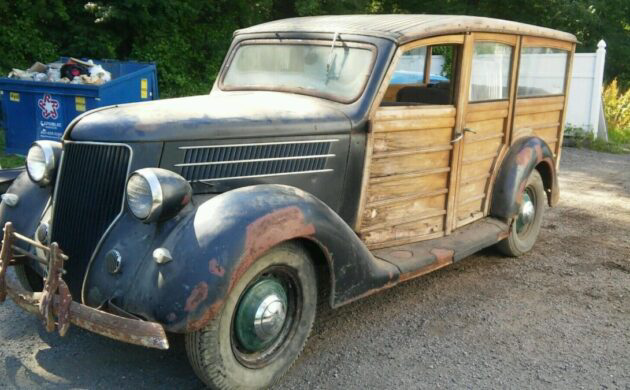
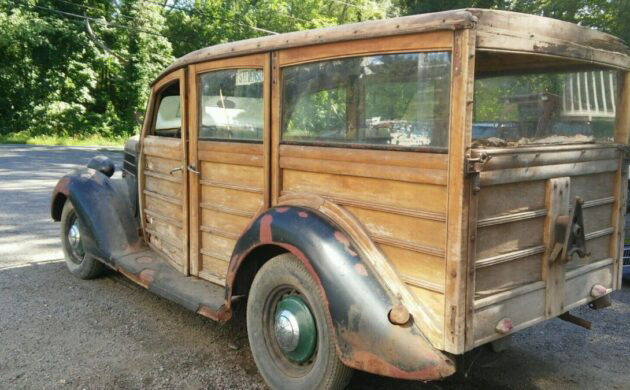

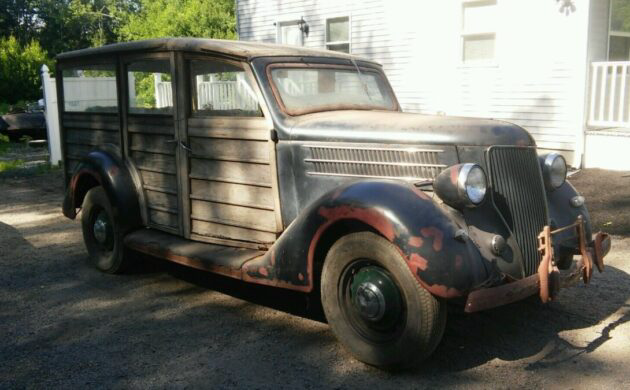
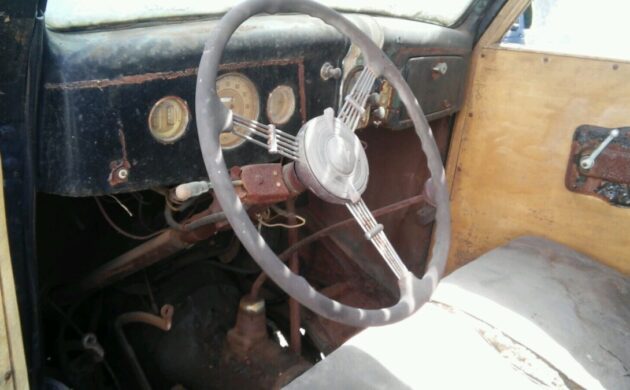
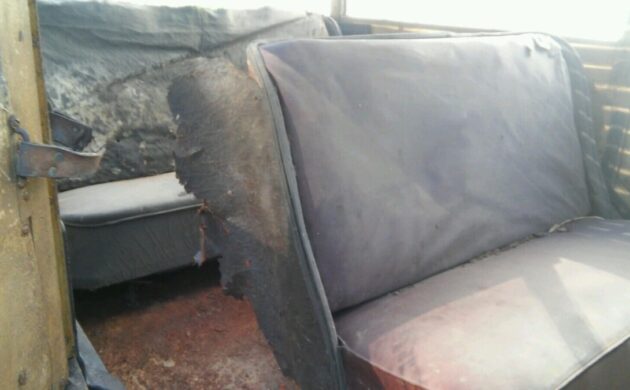
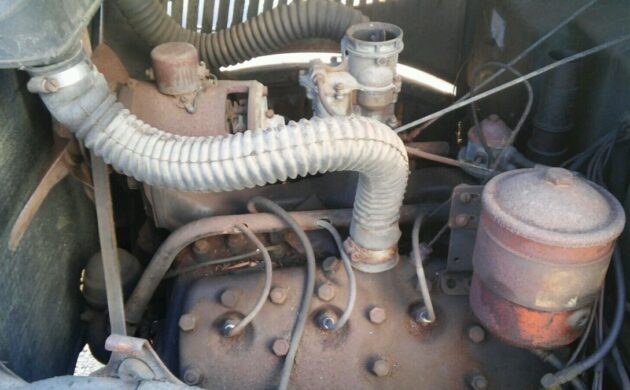


Have seen cars of all kinds on the hundreds of media, TV, car shows, weekend events and no telling where else but I’ve never seen a ’36 Ford Woody. The fact that it’s all there is amazing as well. Wow!
The writer Jeff Bennett is right, the Early Ford V8 Club is an incredible resource for restoring any 1932-53 Ford, or keeping one on the road.
I’m not sure this one should be restored. Might be best to return a few things to original (headlight lenses, hood ornament, eliminate the aftermarket front turn signals), get it road-safe and enjoy it the way it was meant to be driven. It’s original only once.
The rusted line across the dash is not a factory seam. I don’t understand why anyone would cut and re-weld that area but the original ’36 dash was a single rolled piece of sheet metal with a chrome “waterfall” added to cover the area near the original center-mounted ash tray. This one has a Philco accessory radio which replaces the ash tray, valuable if working but most require a complete rebuild. The tube radio is a separate box and the visible part is a remote dial. Locking glove box handle is another dealer accessory.
I’ve learned the hard way (on my ’36 Cabriolet restoration) the windshield trim might hide a major amount of rust, and a long list of other gotchas. But I see a lot of great things with this one.
Those tires don’t have date codes and were made before Firestone had a zip code…
Would love to see that cabriolet when it’s finished.
Could this have been a right had drive English Ford and converted to left drive?
“I got a ’30 (ish) Ford wagon and we call it a woodie”, although, the actual cars age was disputed, “Surf City” was actually Huntington Beach, ( some say Venice Beach or Malibu), and only 1 band member could actually surf, Brian Wilson. Glaring mistakes aside, the Beach Boys were huge, we loved them, good old fashioned wholesome music even the old man would listen to, and then “Along came Mary”, and the British Invasion, and it was goodbye surfin’ music, in exchange for Led Zepplin, and with it, I think the woodie hype fell silent.
Wood vehicles were incredibly expensive to produce, and with hardwood prices changing hourly today, it’s gonna cost you plenty to restore. I think there is still some interest in woodies, with some folks seemingly bottomless pockets today, someone will take this on. Just don’t be surprised when done it has some 900hp motor, puffy interior and clown wheels, and that’s okay too.
It was Dennis Wilson that was the only member of the Beach Boys who could surf, and tragically died from drowning ( not from surfing) . Brian Wilson and Jan Berry wrote the song Surf City , but it was sung by Jan and Dean
Howard:
Dennis Wilson was the real surfer of The Beach Boys, he was also the one who owned Corvettes, Cobras, and he even had a 1967 Ferrari 250GT Lusso(originally owned by Sam Cooke) with a trailer hitch.
Ref:
https://www.autoweek.com/car-life/classic-cars/a33500753/the-strange-life-of-a-lusso/
TED WALTHER, I enjoyed that read a lot. Thanks for supplying it. Poor Ferrari but it has outlasted the abuse and is in fine shape now. If cars could talk what a tale it would spin…
As for the Woody, it’ll be restored . It’s another car that could tell many stories that I’d love to hear…
And some say “Surf City” was down in Doheny, where the surfers all go . . .
GO GO Surfer Joe Ho Ho,
Now Look at him Go Man Go
Go oh Ho Ho Ho
Surfer Joe.
bobhess, I won’t disbute the fact that Woodie’s are rare, and I don’t claim to know the actual production numbers. But, the fact that you haven’t seen a 36 Woodie ,and you have seen others, doesn’t mean much. I have seen allot of 36’s, 35’s and 37’s and all that means, I have been at allot of events ,with many Woodies in attendance. I would speculate, if you checked the production numbers on all the years, there would not be a big ditterence from year to year.
This –> “I’m not sure this one should be restored. Might be best to return a few things to original (headlight lenses, hood ornament, eliminate the aftermarket front turn signals), get it road-safe and enjoy it the way it was meant to be driven. It’s original only once.”
I don’t always say that, but in this case, I totally agree with Kendra.
The wood part seems intact enough to at least use as templates for cutting out new pieces. I’d buy it if it were closer.
Here’s a beautifully restored 36 Ford Woodie that sold on BAT for $55k’
https://bringatrailer.com/listing/1936-ford-woodie/
Do a Google search and you’ll find lots of them.
Edward Kingsford’s wife was a cousin of Henry Ford.
https://en.wikipedia.org/wiki/Kingsford_(charcoal)
Henry Ford also said he would fire anyone that damage the crates the engines came in because he used them as floorboards for the model T’s.
Sold for $13,600, I think someone got a very good deal here. A big, big project but well worth the effort when all is said and done. I sure would like to see this old girl when all restored and back on the road again!